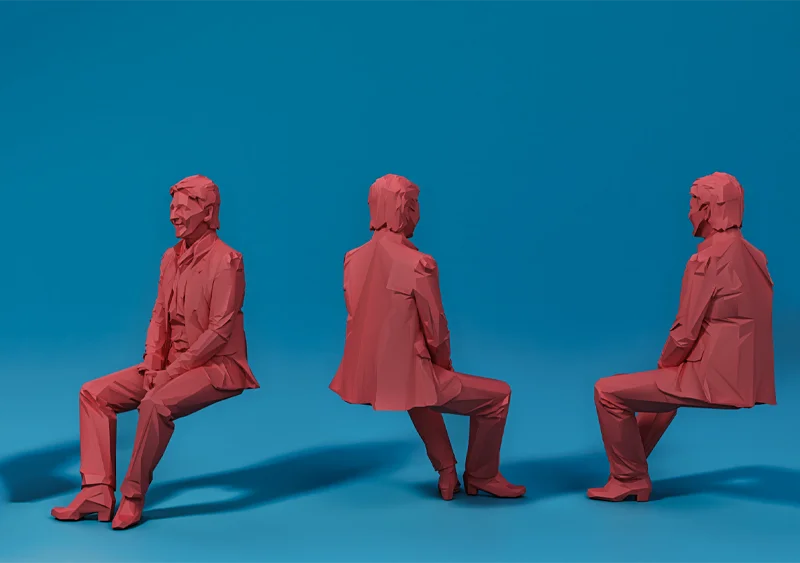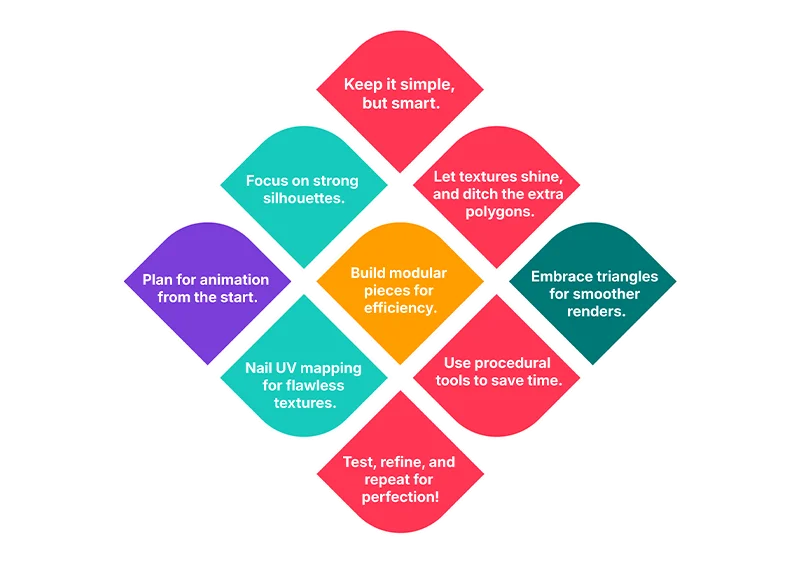9 Proven Techniques for Effective Low Poly 3D Models
Learn the best practices for creating efficient low poly 3D models

6 MIN READ
January 9, 2025

Written By
Sasikumar Janakiraman
Creating low poly 3D models has evolved into a critical skill in many industries, from gaming to simulations and
marketing. Be it you're designing a low poly moveable 3D model or a low poly rigable 3D model, precision and
creativity are vital. Below are nine techniques to help you optimize your models for functionality and
aesthetics.

1. Keep It Simple, But Smart
The first rule of low poly modeling is this: don’t overcomplicate things. But simplicity doesn’t mean sacrificing functionality. For instance, when creating a low poly moveable 3D model, strip down the geometry to its essentials while ensuring key features (like joints and moving parts) remain intact.
Pro Tip:
Focus on the model’s purpose. Is it for animation? A static prop? A crowd filler? Let its end use decide how
much detail you can trim.
2. Nail the Silhouette
Ever noticed how you can recognize objects even when they’re far away or backlit? That’s the power of a strong silhouette. For a low poly crowd 3D model, where multiple figures are present, each one should be instantly recognizable based on its shape.
Practical Insight:
Experiment with exaggerated proportions for models that need to stand out in busy scenes. A wider torso, angular
limbs, or iconic props can work wonders in making your crowd assets visually engaging.
3. Let Textures Do the Talking
Why add dozens of polygons when a good texture can achieve the same effect? Textures add depth and personality to your model without increasing complexity. Take a low poly Hitler 3D model, for instance: you can achieve the essence of uniforms and facial details using smart texturing rather than intricate geometry.
Pro Tip:
Use clean UV unwrapping to avoid distortion, and always test textures in the final lighting setup to ensure they
work as intended.
4. Think Animation From the Start
If your model will move, dance, or fight, you need to plan ahead. Low poly rigable 3D
models require well-placed edge loops around joints like shoulders, elbows, and knees to ensure
smooth deformation.
Expert Insight:
Avoid long, stretched polygons near articulation points. They can cause ugly pinching during movement. Instead,
maintain consistent polygon density for a more fluid look.
Looking for 3D Modeling Services? Get it under $100 through Global 3D Design Studio!
5. Modular is Magical
Why build every model from scratch when you can create reusable pieces? Modular modeling is a lifesaver in large projects. For example, low poly crowd 3D models often use modular body parts like heads, torsos, and limbs that can be mixed and matched to create dozens of unique characters.
Practical Use:
This approach is excellent for game environments, where you need variety without draining time or resources.
6. Triangles Are Your Best Friend
Unlike high-poly models, low poly designs thrive on triangular geometry. Triangles are lightweight and predictable, making them ideal for low poly rigable 3D models.
Quick Fact:
Game engines like Unity and Unreal Engine automatically convert quads into triangles during rendering. Designing
with triangles from the start ensures better control over the final model.
7. Master UV Mapping
Textures are only as good as your UV maps. Poor UV mapping can ruin an otherwise perfect model. This is especially true for assets like a low poly Hitler 3D model, where historical accuracy might demand precise alignment of facial and clothing textures.
Actionable Tip:
Use software like Blender’s
Smart UV Project or RizomUV to get started with
efficient UV layouts. Always pack your UV islands tightly to minimize wasted texture space.
8. Use Procedural Tools to Save Time
Procedural modeling is a game-changer for repetitive tasks. When designing low poly crowd 3D models, procedural tools can automatically generate dozens (or hundreds) of variations based on predefined parameters.
Tools to Try:
Check out Houdini for advanced procedural setups or Blender’s Geometry Nodes for lightweight solutions.
9. Test, Refine, Repeat
No model is perfect on the first go. Always test your low poly moveable 3D model in its intended environment, whether that’s a game engine, AR/VR setup, or animation sequence. Pay attention to how it looks, moves, and performs under real-world conditions.
Final Checkpoint:
Run the model through stress tests: animations, lighting changes, and even close-ups. Spot flaws early to save
headaches later.
Bonus Tips for B2B Applications
- Prioritize Lightweight Files
Clients love assets that are easy to handle. Optimize your files by removing unnecessary history and cleaning up unused elements. - Collaborate With Developers
For B2B projects, your models are often part of a larger pipeline. Open communication with developers ensures your low poly rigable 3D model works seamlessly in its final setup. - Stay Updated on Trends
Low poly modeling is evolving. Tools like Unreal Engine’s Nanite and Blender’s AI-assisted features can make your workflow faster and more efficient.
Final Thoughts
Low poly 3D modeling focuses on strategic decisions that maximize value while keeping resource usage minimal. By applying these techniques, you can ensure that your low poly moveable 3D models, low poly rigable 3D models, and low poly crowd 3D models are ready to impress clients, meet project goals, and elevate your B2B portfolio.
Collaborate with the Premier International 3D Design Studio for Low Poly Models
About the writer :
Sasikumar Janakiraman, as the Creative Director at Zealous Services, brings a unique mix of creativity and technical ... skill. He’s passionate about 2D and 3D design, leading teams to create stunning 3D models and visualizations. Sasikumar loves working closely with clients, making sure their ideas come to life in the best possible way. His goal? To make design feel simple and exciting.
Read MoreFrequently Asked Questions (FAQ)
What industries benefit the most from low poly 3D models?
Low poly 3D models are widely used in gaming, virtual reality, augmented reality, and simulation training due to their efficiency and quick rendering. Additionally, industries like architecture, e-commerce, and marketing rely on low poly models to create interactive visualizations and scalable designs without compromising on performance.
How do I choose the right software for low poly modeling?
The choice of software depends on your project requirements. For flexibility and affordability, Blender is a popular choice with extensive tools for low poly modeling. For industry-standard workflows, Maya and 3ds Max excel in animation and complex projects. Houdini is ideal for procedural modeling, especially for large-scale environments or crowds.
Can low poly models achieve realistic results, or are they strictly stylistic?
While low poly models are known for their distinct stylized look, they can achieve realistic results with the right textures, lighting, and shading techniques. Combining smart UV mapping and high-quality textures can give the illusion of detail without increasing polygon counts, making them suitable for various styles and purposes.
What’s the best way to ensure low poly models work seamlessly in game engines?
Start by adhering to the polygon budget specified by the game engine or project requirements. Optimize geometry, keep textures lightweight, and test frequently in engines like Unity or Unreal. Export your models in compatible formats such as FBX or OBJ, ensuring materials and animations are preserved during import. How can I make low poly models stand out in a competitive market?